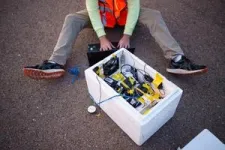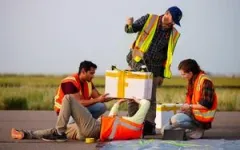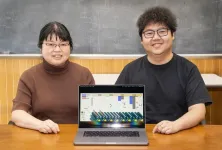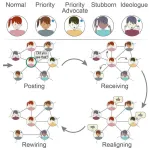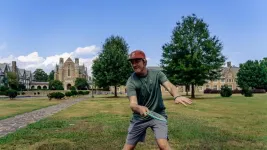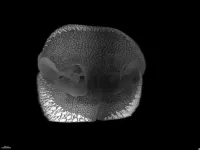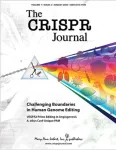(Press-News.org) ALBUQUERQUE, N.M. — Dangling from a weather balloon 80,000 feet above New Mexico, a pair of antennas sticks out from a Styrofoam cooler. From that height, the blackness of space presses against Earth’s blue skies. But the antennas are not captivated by the breathtaking view. Instead, they listen for signals that could make air travel safer.
Researchers from Sandia National Laboratories and Ohio State University are taking experimental navigation technology to the skies, pioneering a backup system to keep an airplane on course when it cannot rely on global positioning system satellites.
More than 15 miles below the floating cooler, cell phone towers emit a steady hum of radio frequency waves. Hundreds of miles above, non-GPS communications satellites do the same.
The idea is to use these alternative signals to calculate a vehicle’s position and velocity.
“We’re not trying to replace GPS,” Sandia lead researcher Jennifer Sanderson said. “We’re just trying to assist it in situations where it’s degraded or compromised,” which can lead to dangerous situations for pilots and passengers.
The team presented its preliminary data at the Institute of Navigation GNSS+ conference, held from Sept. 16-20 in Baltimore. The research is supported by Sandia’s Laboratory Directed Research and Development program.
The case for a GPS backup
There is no question GPS is still the gold standard for navigation. It’s fast, precise and reliable. Which might raise the question: Why are researchers developing new navigation methods?
“I worry about relying too heavily on it without a backup,” said Sanderson, an expert in navigation algorithms.
GPS, she said, has become part of the fabric of our modern, technological world. As a society, we are constantly plugged into it, whether we are landing a plane, driving through town, mapping crop yields or timing transactions in stock markets. This reliance has researchers like Sanderson concerned about the consequences if the connection is disrupted.
“The impacts of losing GPS could be felt throughout society,” she said. Disruptions to GPS are not uncommon. Pilots flying near conflict areas are increasingly likely to lose GPS or discover it is unreliable. The longer they fly without GPS, the higher the risk of accidents.
“Commercial GPS receivers are susceptible to a couple different threats, one being jamming,” Sanderson said. Jammers, devices that overwhelm receivers with meaningless signals on GPS frequencies, are illegal but commercially available.
Another problem, she said, is spoofing, which involves using a fake signal to mislead receivers into believing they are in a different location. The technique is no secret, as gaming communities use it to cheat in location-based games like Pokémon Go.
“There are actual apps you can download that allow you to spoof your location, and entire subreddits dedicated to showing you how to use it for various games,” Sanderson said.
While spoofing a game may be relatively harmless, Sanderson emphasized it can have real-world consequences when directed at a vehicle. Pilots might not be able to tell if a signal is spoofed or genuine, leading them in the wrong direction.
Project studies signals-of-opportunity at high altitude
Sanderson’s idea of navigating using non-GPS signals that happen to be nearby is not entirely new. Scientists refer to it as “signals of opportunity” but have primarily studied it on and near the ground. It has been proposed as a way for autonomous vehicles to navigate through urban canyons, where GPS signals are blocked by towering buildings.
However, it is not a simple task. Instead of extracting time and location information from a GPS signal, receivers of signals-of-opportunity sometimes measure the physical characteristics of radio frequency waves instead.
For example, they can use what’s called the Doppler effect. Radio waves from a satellite moving toward a receiver become compressed as they travel, while radio waves from a satellite moving away become stretched out. With some advanced mathematics and enough signals, scientists can determine the source of the signals and calculate the receiver’s position.
Sanderson and her team are studying signals-of-opportunity navigation at high altitudes. If they can collect signal data from the stratosphere, they may be able to develop a way to guide vehicles, such as aircraft, using a network of atmospheric radio frequency waves. “So, we strap our payloads to these weather balloons and launch them into the air,” she said.
The payloads, which consist of electronic packages attached to a pair of antennas and bundled into an insulated foam cooler, hold the key to understanding signals high above the clouds. Satellite signals are expected to be strong, but there may be dead zones due to the cone-shaped transmission pattern that narrows closer to the source. Satellite coverage over rural areas, like much of New Mexico, may be too sporadic to be useful. The strength of cell tower signals can be calculated theoretically, but it needs to be characterized to be useful in a real-world situation.
“So far, the highest altitude we’ve reached is about 80,000 feet. In comparison, other studies we’ve seen have focused on 5,000 to 7,000 feet.”
Processing data is the next step of team’s scientific journey
As researchers continue to process their first batch of data, they look forward to new milestones and new challenges.
“The not-sexy but very important side of navigation is understanding all your error sources,” Sanderson said. “My goal is to have a robust dataset to develop algorithms for real-time systems, enabling hardware tests using actual live-sky data.”
Eventually, a functional navigation system will need to match signals to their transmitters in real-time and then calculate position and velocity relative to those sources. However, in this early stage of the research, her team is manually matching received signals to nearby satellites using reference data.
“It can be quite tedious. So, one big aspect we need to address is automating this process,” she said.
Despite the challenges, she remains optimistic.
“While we are still processing the flight data, we believe our preliminary findings indicate that we detected cell tower signal beacons at our peak altitude of about 82,000 feet. If these signals are clean enough for navigation, it will significantly change what we thought was possible for alternative navigation,” Sanderson said.
Sandia National Laboratories is a multimission laboratory operated by National Technology and Engineering Solutions of Sandia LLC, a wholly owned subsidiary of Honeywell International Inc., for the U.S. Department of Energy’s National Nuclear Security Administration. Sandia Labs has major research and development responsibilities in nuclear deterrence, global security, defense, energy technologies and economic competitiveness, with main facilities in Albuquerque, New Mexico, and Livermore, California.
END
Study asks: Can cell phone signals help land a plane?
Sandia Labs, Ohio State look to the skies to protect aircraft against GPS outages
2024-10-22
ELSE PRESS RELEASES FROM THIS DATE:
Artificial intelligence is creating a new way of thinking, an external thought process outside of our minds
2024-10-22
The interaction between humans and artificial intelligence is shaping a new thinking system, a new cognitive scheme, external to the human mind, but capable of enhancing its cognitive abilities. This is called System 0, which operates alongside the two models of human thought: System 1, characterized by intuitive, fast, and automatic thinking, and System 2, a more analytical and reflective type of thinking. However, System 0 introduces an additional level of complexity, radically altering the cognitive landscape in which ...
Reaction conditions tune catalytic selectivity
2024-10-22
UPTON, N.Y. — Chemists at the U.S. Department of Energy’s (DOE) Brookhaven National Laboratory have developed a new theoretical framework for more accurately predicting the behavior of catalysts. These collections of atoms lower the energy needed for countless chemical reactions. The study reveals how conditions such as temperature and pressure can change a catalyst’s structure, efficiency, and even the products it makes. The findings are published in the journal Chem Catalysis.
“Our results highlight the significant impact ...
Verified users on social media networks drive polarization and the formation of echo chambers
2024-10-22
When X (formerly Twitter) changed its verification system in 2022, many foresaw its potential to impact the spread of political opinions on the platform. In a modeling study publishing October 22 in the Cell Press journal iScience, researchers show that having verified users whose posts are prioritized by the platform’s algorithms can result in increased polarization and trigger the formation of echo chambers. Because X’s new verification system allows almost anybody to become verified, this side effect could be taken advantage of by users wishing to manipulate others’ opinions, the researchers say.
“Our findings confirm ...
Get a grip: The best thumb position for disc launch speed and spin rate
2024-10-22
WASHINGTON, Oct. 22, 2024 – Disc golf is a sport growing in popularity, but there hasn’t been much research into the best techniques – until now.
Researcher Zachary Lindsey and his team studied professional and amateur disc golf players in Georgia to analyze the effect of thumb grip on disc-throwing.
“Participants were eager and excited to engage in the study, as there is clearly a thirst for scientific evidence and data to drive progress in the sport so that disc golf enthusiasts can improve their game in recreational and competitive contexts,” ...
Maternal eating disorders, BMI, and offspring psychiatric diagnoses
2024-10-22
About The Study: In this population-based cohort study including 392,000 mothers and 649,000 offspring, offspring from mothers with an eating disorder history or pre-pregnancy body mass index (BMI) outside normal weight were at higher risk of psychiatric disorders. The results differed somewhat between the 2 exposures with regard to which offspring diagnoses had associations, and effect sizes were typically larger for maternal eating disorders vs BMI. These findings suggest a need to consider these 2 exposures clinically to help prevent offspring mental illness.
Corresponding Author: To contact the corresponding author, Ida A. K. Nilsson, PhD, email ida.nilsson@ki.se.
To ...
Geometric mechanics shape the dog's nose
2024-10-22
The noses of many mammals, such as dogs, ferrets and cows, feature grooves forming a multitude of polygons. A team from the University of Geneva (UNIGE) has analyzed in detail how these patterns form in the embryo using 3D imaging techniques and computer simulations. The researchers discovered that differential growth of the skin tissue layers leads to the formation of domes, which are mechanically supported by the underlying blood vessels. This work describes for the first time this morphogenetic process, which could help explain the formation of other biological structures ...
‘Visual clutter’ alters information flow in the brain
2024-10-22
New Haven, Conn. — Whether we’re staring at our phones, the page of a book, or the person across the table, the objects of our focus never stand in isolation; there are always other objects or people in our field of vision. How that visual “clutter” affects visual processing in the brain, however, is not well understood.
In a new study published Oct. 22 in the journal Neuron, Yale researchers show that this clutter alters how information flows in the brain, as does the precise location of that clutter within the wider field of vision. The findings ...
Researchers succeed in taking 3D x-ray images of a skyrmion
2024-10-22
A difficult-to-describe nanoscale object called the magnetic skyrmion might one day yield new microelectronic devices that can do much more — for example, massive data storage — all while consuming much less power.
But researchers need a more detailed understanding of skyrmions if they are ever to be used reliably in computational devices, including quantum computers. Peter Fischer, a senior researcher at the Department of Energy’s Lawrence Berkeley National Laboratory (Berkeley ...
MRI can save rectal cancer patients from surgery, study suggests
2024-10-22
Magnetic resonance imaging (MRI) can spare many patients with rectal cancer from invasive surgery that can carry lifelong side effects, new research indicates.
The findings, from UVA Cancer Center’s Arun Krishnaraj, MD, MPH, and collaborators, indicate that MRI can predict patient outcomes and the risk of the tumor reccurring or spreading for patients who have undergone chemotherapy and radiation.
That information could be extremely useful in determining the best course of treatment and deciding whether a patient can ...
Fyodor Urnov on clinical crisis in CRISPR genome editing
2024-10-22
New Rochelle, NY, October 18, 2024—An invited Guest Editorial entitled “Give Cas a Chance,” by Fyodor Urnov, PhD, Director of Technology & Translation at the Innovative Genomics Institute (IGI), anchors the October 2024 special issue of The CRISPR Journal on “CRISPR Trials.”
As guest editor of the special issue, Dr. Urnov has penned an extraordinary editorial that emphatically defines the magnitude of the crisis in the genome editing arena and offers a path forward. The inherently programmable nature of CRISPR gene editing that makes it ...
LAST 30 PRESS RELEASES:
Making lighter work of calculating fluid and heat flow
Normalizing blood sugar can halve heart attack risk
Lowering blood sugar cuts heart attack risk in people with prediabetes
Study links genetic variants to risk of blinding eye disease in premature infants
Non-opioid ‘pain sponge’ therapy halts cartilage degeneration and relieves chronic pain
AI can pick up cultural values by mimicking how kids learn
China’s ecological redlines offer fast track to 30 x 30 global conservation goal
Invisible indoor threats: emerging household contaminants and their growing risks to human health
Adding antibody treatment to chemo boosts outcomes for children with rare cancer
Germline pathogenic variants among women without a history of breast cancer
Tanning beds triple melanoma risk, potentially causing broad DNA damage
Unique bond identified as key to viral infection speed
Indoor tanning makes youthful skin much older on a genetic level
Mouse model sheds new light on the causes and potential solutions to human GI problems linked to muscular dystrophy
The Journal of Nuclear Medicine ahead-of-print tip sheet: December 12, 2025
Smarter tools for peering into the microscopic world
Applications open for funding to conduct research in the Kinsey Institute archives
Global measure underestimates the severity of food insecurity
Child survivors of critical illness are missing out on timely follow up care
Risk-based vs annual breast cancer screening / the WISDOM randomized clinical trial
University of Toronto launches Electric Vehicle Innovation Ontario to accelerate advanced EV technologies and build Canada’s innovation advantage
Early relapse predicts poor outcomes in aggressive blood cancer
American College of Lifestyle Medicine applauds two CMS models aligned with lifestyle medicine practice and reimbursement
Clinical trial finds cannabis use not a barrier to quitting nicotine vaping
Supplemental nutrition assistance program policies and food insecurity
Switching immune cells to “night mode” could limit damage after a heart attack, study suggests
URI-based Global RIghts Project report spotlights continued troubling trends in worldwide inhumane treatment
Neutrophils are less aggressive at night, explaining why nighttime heart attacks cause less damage than daytime events
Menopausal hormone therapy may not pose breast cancer risk for women with BRCA mutations
Mobile health tool may improve quality of life for adolescent and young adult breast cancer survivors
[Press-News.org] Study asks: Can cell phone signals help land a plane?Sandia Labs, Ohio State look to the skies to protect aircraft against GPS outages

